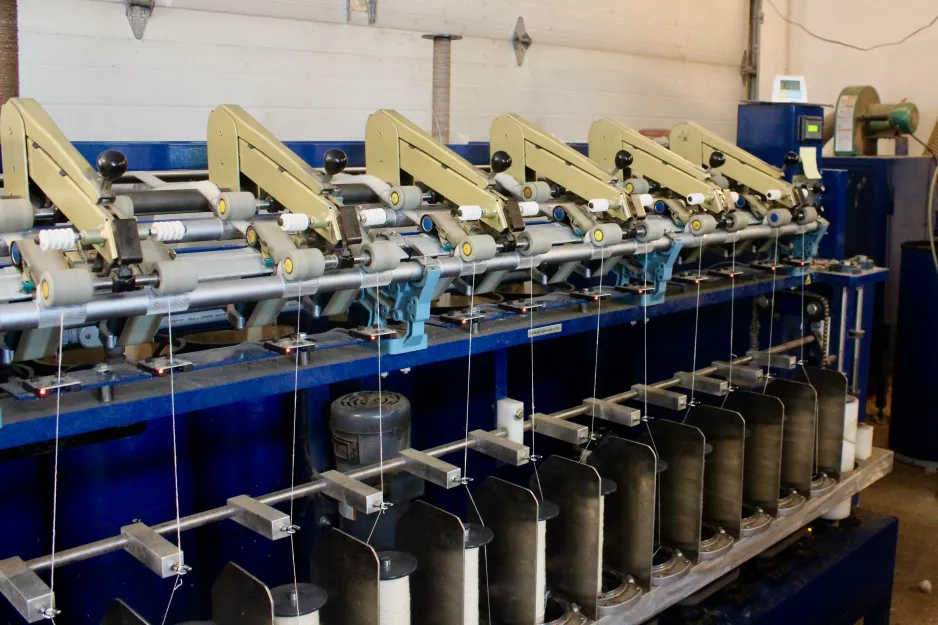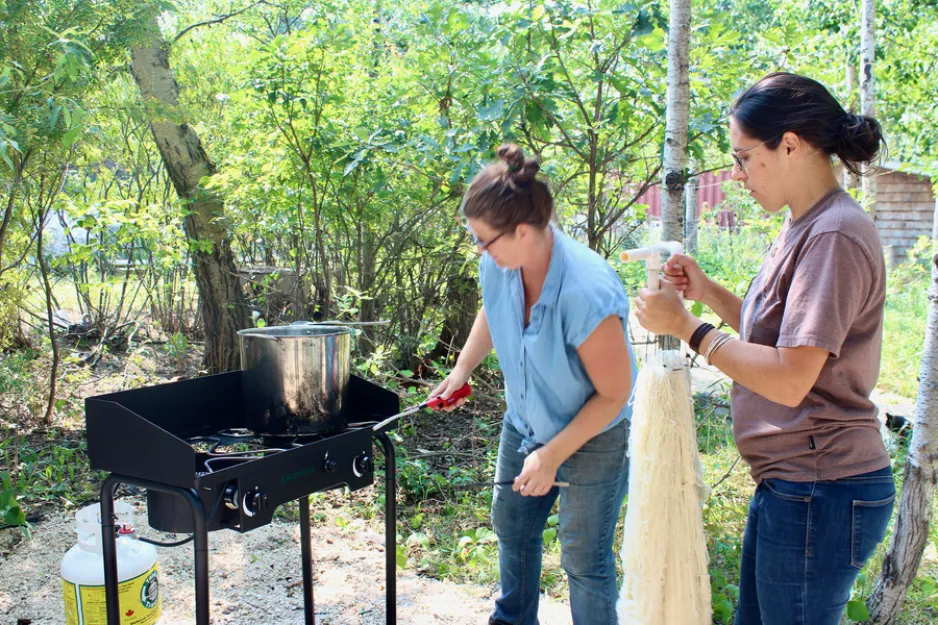Wool in the Pembina Fibreshed
As Christel Lanthier, fibre farmer at Ferme Fiola Farm near Winnipeg, Manitoba, has noted, “Very often we talk about local food…it’s not very often that we talked about local textiles….We have so many fibres that we can grow here, in our region, that are renewable.”1 Given that it is not a common topic of conversation, I was very fortunate to speak at length last year with Lanthier and others about regional textiles and the fibreshed movement in Manitoba.
A fibreshed is the geographical region in which fibres are produced and processed into textiles. The term was developed in the early 2010s by Rebecca Burgess in Northern California and borrows from the concept of a watershed—the land that drains into lakes and rivers, which then flows into a common outlet. A fibreshed encompasses all aspects of the textile system, including growing fibres and dyes; making tools; and spinning, weaving, and knitting.
Fibreshed is also the name for the non-profit organization, founded by Burgess, that supports and develops regional fibre and textile systems. This organization, and the related grassroots movement, ask the questions: where do fibres and colours come from? What happens at the end of the textile’s life cycle? Who is affected by production? Fibershed strives to rebuild regional manufacturing and adopt climate-conscious agricultural practices. It is concerned with ecosystem health, as well as racial and economic equity.2 Though the organization started in California, it offers an international affiliate program to support and develop regional fibre and textile systems. In 2018, Margaret Brook and Anna Hunter established the Pembina Fibreshed as an official affiliate of Burgess’s Fibershed. In advocating and supporting fibre production in southern Manitoba, the Pembina Fibreshed connects fibre producers and processors and organizes various educational initiatives and workshops. One of the Pembina Fibreshed’s major initiatives is the annual Manitoba Fibre Festival, which includes a large market, workshops, and demonstrations.

Long Way Homestead’s spinner, made by Belfast Mini Mills. The spinner takes roving, a thin, rope-like bundle of fibre, and winds it into yarn. The yarn is then steamed so that it holds the twist.
Last year, I was hired by Ingenium to interview several Pembina Fibreshed members as part of a research project into local textiles. These lively, informative, and fulfilling farm visits focused on processes, technologies, motivations, and community. My conversations with the fibreshed members generally revolved around wool: most (but not all) regional fibre production relies on sheep, because of Manitoba’s harsh climate. Wool is also a wonderful fibre. When asked about the importance of wool, Long Way Homestead’s Anna Hunter laughed and stated: “How dorky is this? I just sort of feel like wool is everything. It's this amazing renewable resource that grows back every year. Sheep need access to grass, water, and sunlight and they grow this fibre every year. It is exceedingly more flexible than cotton, it is compostable, it'll break down in the soil within six months, which is amazing when we look at the other end of our textiles. Plus, when sheep are managed properly, they can actually contribute to sequestering more carbon in our grasslands, building healthy ecosystems, and managing our landscape.”
During this project, I learned, and documented, how wool can be processed manually with small tools, or, more efficiently, in mills. Both manual and industrial wool processing uses the same steps: raising sheep to grow wool; shearing; skirting the wool to remove soiled portions; scouring with boiling water to remove excess grease; picking or teasing the tight locks apart; carding or combing fibres to lie parallel; spinning fibres into yarn; plying strands of yarn together; dyeing skeins of yarn; marketing and selling the product.
One of the challenges with local textiles is a lack of processing infrastructure. Though Anna Hunter runs a small wool mill at her fibre farm, there are not many mills in Canada that process wool. Canadian sheep are primarily raised for meat and wool is viewed as a by-product. Critical shortages of wool-processing infrastructure lead to the majority of wool being discarded, or shipped overseas for processing. The Pembina Fibreshed aims to address the environmental impacts of the current industrial practices by processing locally and preventing waste. Barb Mulock of Prairie’s Edge Wool Farm noted that many members and supporters of the Pembina Fibreshed share values about local markets and using all aspects of livestock.

Anna Hunter lights her outdoor stove to begin boiling water while Christel Lanthier inspects the dyeing frame from which the wool will hang.
The farmers with whom I met were beyond generous, offering me food from their gardens. After the formal interviews concluded, we shared in conversation over fresh pie or tea at cozy kitchen tables and scenic front porches. This welcoming nature reflects how community is a strong and important part of the fibreshed. While I was at Long Way Homestead, Christel Lanthier joined Anna Hunter and me in the outdoor classroom for a natural dyeing demonstration. It was endearing to watch the women laugh together over the dye pot, collaborating to colour yarn milled by Anna and made from the fleece of Christel’s sheep. The sense of loyalty extends to patrons as well; the farmers know many of their customers quite closely.

Remko Stalman shears a sheep at the 2023 Fibre Festival, an annual event hosted by the Pembina Fibreshed on the grounds of the Red River Exhibition Park near Winnipeg, Manitoba, Treaty One Territory.
A highlight of my work was the annual Manitoba Fibre Festival, where Remko Stalman demonstrated the art of sheep shearing. The sheep farmers had emphasized the difficulty of shearing and I had been skeptical. However, in watching Remko’s technique, I better understood how much skill is required to calm and steady a live animal in one arm while holding a razor-sharp (literally) implement in the other!
Thank you to: Christel Lanthier, Anna Hunter and Barb Mulock for the enjoyable conversations and for welcoming me onto your farms; Remko Stalman and other vendors at the Manitoba Fibre Festival for the explanations and candid demonstrations; Molly McCullough for kind, patient guidance.
1 All quotes are from the Pembina Fibreshed Documentation Project, Ingenium.
2 “Mission & Values,” fibershed.org/mission-vision/.
Enjoying the Ingenium Channel? Help us improve your experience with a short survey!
















